Application of the SWAT-EFDC Linkage Model for Assessing Water Quality Management in an Estuarine Reservoir Separated by Levees
Abstract
:1. Introduction
2. Materials and Methods
2.1. Study Area and Bottom Soil Characteristics of the Estuarine Reservoir
2.2. SWAT-EFDC Linkage Model
2.3. EFDC Model Setup
2.4. Scenario Description
3. Results
3.1. Model Calibration and Validation Results
3.2. Reservoir Simulation Result
3.2.1. Zone A Simulation Results
3.2.2. Zone B Simulation Results
3.3. Total Phosphorus Reduction Efficiency Analysis Result
4. Conclusions
Author Contributions
Funding
Institutional Review Board Statement
Informed Consent Statement
Conflicts of Interest
References
- NOAA. Available online: https://oceanservice.noaa.gov/facts/estuary.html (accessed on 9 December 2020).
- Gray, J.S. Marine biodiversity: Patterns, threats and conservation needs. Biodivers. Conserv. 1997, 6, 153–175. [Google Scholar] [CrossRef]
- Schubel, J.; Kennedy, V.S. The Estuary as a Filter: An Introduction; Elsevier BV: Amsterdam, The Netherlands, 1984; pp. 1–11. [Google Scholar]
- Jang, J.R.; Lee, S.H.; Cho, Y.; Choi, J.Y. A Calculation of Agricultural Water Demand According to the Farmland Developing Plan on the Saemangeum Tidal Land Reclamation Project. Korean Natl. Comm. Irrig. Drain. 2014, 21, 1–16. [Google Scholar]
- Suh, S.-W.; Kim, J.-H.; Hwang, I.-T.; Lee, H.-K. Water quality simulation on an artificial estuarine lake Shiwhaho, Korea. J. Mar. Syst. 2004, 45, 143–158. [Google Scholar] [CrossRef]
- Hwang, S. Dynamic Resilience Assessment for Water Quality Management of Estuarine Reservoir using SWAT-EFDC Model. Ph.D. Thesis, Seoul National University, Seoul, South Korea, 2020. [Google Scholar]
- Conrad, S.R.; Santos, I.R.; White, S.; Sanders, C.J. Nutrient and Trace Metal Fluxes into Estuarine Sediments Linked to Historical and Expanding Agricultural Activity (Hearnes Lake, Australia). Chesap. Sci. 2019, 42, 944–957. [Google Scholar] [CrossRef]
- Lee, Y.G.; Kang, J.-H.; Ki, S.J.; Cha, S.M.; Cho, K.H.; Lee, Y.S.; Park, Y.; Lee, S.W.; Kim, J.H. Factors dominating stratification cycle and seasonal water quality variation in a Korean estuarine reservoir. J. Environ. Monit. 2010, 12, 1072–1081. [Google Scholar] [CrossRef] [PubMed]
- Song, Y.-H.; Choi, M.-S.; Ahn, Y.-W. Trace metals in Chun-su Bay sediments. J. Korean Soc. Oceanogr. Sea 2011, 16, 169–179. [Google Scholar] [CrossRef]
- Lee, D.-K.; Kim, K.-H.; Lee, J.-S. Hypoxia and Characteristics of Nutrient Distribution at the Bottom Water of Cheonsu Bay Due to the Discharge of Eutrophicated Artificial Lake Water. J. Korean Soc. Mar. Environ. Saf. 2016, 22, 854–862. [Google Scholar] [CrossRef]
- Park, H.S.; Lim, H.S.; Hong, J.S. Spatio and temporal patterns of benthic environment and macrobenthos community on subtidal soft- bottom in Chonsu Bay, Korea. J. Korean Fish. Soc. 2000, 33, 262–271. [Google Scholar]
- Jha, D.K.; Devi, M.P.; Vidyalakshmi, R.; Brindha, B.; Vinithkumar, N.V.; Kirubagaran, R. Water quality assessment using water quality index and geographical information system methods in the coastal waters of Andaman Sea, India. Mar. Pollut. Bull. 2015, 100, 555–561. [Google Scholar] [CrossRef]
- Nangia, V.; De Fraiture, C.; Turral, H. Water quality implications of raising crop water productivity. Agric. Water Manag. 2008, 95, 825–835. [Google Scholar] [CrossRef]
- Liu, Z.; Hashim, N.B.; Kingery, W.L.; Huddleston, D.H.; Xia, M. Hydrodynamic Modeling of St. Louis Bay Estuary and Watershed Using EFDC and HSPF. J. Coast. Res. 2008, 10052, 107–116. [Google Scholar] [CrossRef]
- Bicknell, B.R.; Imhoff, J.C.; Kittle, J.L.; Jobes, T.H.; Donigian, A.S. Hydrological Simulation Program-Fortran (HSPF). In User’s Manual for Release 12.2; Environmental Protection Agency: Washington, DC, USA, 2005. [Google Scholar]
- Tetra Tech, Inc. The Environmental Fluid Dynamics Code User Manual Report; Environmental Protection Agency: Washington, DC, USA, 2007. [Google Scholar]
- Zhang, Z.; Huang, J.; Zhou, M.; Huang, Y.; Lu, Y. A Coupled Modeling Approach for Water Management in a River-Reservoir System. Int. J. Environ. Res. Public Health 2019, 16, 2949. [Google Scholar] [CrossRef] [Green Version]
- Loos, S.; Shin, C.M.; Sumihar, J.; Kim, K.; Cho, J.; Weerts, A.H. Ensemble data assimilation methods for improving river water quality forecasting accuracy. Water Res. 2020, 171, 115343. [Google Scholar] [CrossRef]
- Kim, K.; Park, M.; Min, J.-H.; Ryu, I.; Kang, M.-R.; Park, L.J. Simulation of algal bloom dynamics in a river with the ensemble Kalman filter. J. Hydrol. 2014, 519, 2810–2821. [Google Scholar] [CrossRef]
- Arnold, J.G.; Kiniry, J.R.; Srinivasan, R.; Williams, J.R.; Haney, E.B.; Neitsch, S.L. Soil and Water Assessment Tool Input/Output Documentation: Version 2012; Texas Water Resources Institute TR 439: College Station, TX, USA, 2012. [Google Scholar]
- Zhu, K.-W.; Chen, Y.-C.; Zhang, S.; Yang, Z.-M.; Huang, L.; Li, L.; Lei, B.; Zhou, Z.-B.; Xiong, H.-L.; Li, X.-X.; et al. Output risk evolution analysis of agricultural non-point source pollution under different scenarios based on multi-model. Glob. Ecol. Conserv. 2020, 23, e01144. [Google Scholar] [CrossRef]
- Volk, M.; Bosch, D.; Nangia, V.; Narasimhan, B. SWAT: Agricultural water and nonpoint source pollution management at a watershed scale. Agric. Water Manag. 2016, 175, 1–3. [Google Scholar] [CrossRef]
- Zhang, P.; Liu, Y.; Pan, Y.; Yu, Z. Land use pattern optimization based on CLUE-S and SWAT models for agricultural non-point source pollution control. Math. Comput. Model. 2013, 58, 588–595. [Google Scholar] [CrossRef]
- Shang, X.; Wang, X.; Zhang, D.; Chen, W.; Chen, X.; Kong, H. An improved SWAT-based computational framework for identifying critical source areas for agricultural pollution at the lake basin scale. Ecol. Model. 2012, 226, 1–10. [Google Scholar] [CrossRef]
- Shen, Z.; Hong, Q.; Yu, H.; Liu, R. Parameter uncertainty analysis of the non-point source pollution in the Daning River watershed of the Three Gorges Reservoir Region, China. Sci. Total. Environ. 2008, 405, 195–205. [Google Scholar] [CrossRef]
- Santhi, C.; Arnold, J.G.; Williams, J.R.; Hauck, L.M.; Dugas, W.A. Application of a Watershed Model to Evaluate Management Effects on Point and Nonpoint Source Pollution. Trans. ASAE 2001, 44, 1559–1570. [Google Scholar] [CrossRef]
- Im, S.; Brannan, K.M.; Mostaghimi, S.; Kim, S.M. Comparison of HSPF and SWAT models performance for runoff and sediment yield prediction. J. Environ. Sci. Health Part A 2007, 42, 1561–1570. [Google Scholar] [CrossRef]
- Hwang, S.; Jun, S.M.; Kim, K.; Kim, S.H.; Lee, H.; Kwak, J.; Kang, M.S. Development of a Framework for Evaluating Water Quality in Estuarine Reservoir Based on a Resilience Analysis Method. J. Korean Soc. Agric. Eng. 2020, 62, 105–119. [Google Scholar] [CrossRef]
- Shin, S.; Her, Y.; Song, J.-H.; Kang, M.-S. Integrated sediment transport process modeling by coupling Soil and Water Assessment Tool and Environmental Fluid Dynamics Code. Environ. Model. Softw. 2019, 116, 26–39. [Google Scholar] [CrossRef]
- Assaf, H.; Saadeh, M. Assessing water quality management options in the Upper Litani Basin, Lebanon, using an integrated GIS-based decision support system. Environ. Model. Softw. 2008, 23, 1327–1337. [Google Scholar] [CrossRef]
- Kim, J.; Lee, S.; Shin, J.; Lim, J.; Na, Y.; Joo, S.; Shin, M.; Choi, J. Effect of Paddy BMPs on Water Quality and Policy Consideration in Saemangeum Watershed. J. Wetl. Res. 2018, 20, 304–313. [Google Scholar] [CrossRef]
- Keipert, N.; Weaver, D.; Summers, R.; Clarke, M.; Neville, S. Guiding BMP adoption to improve water quality in various estuarine ecosystems in Western Australia. Water Sci. Technol. 2008, 57, 1749–1756. [Google Scholar] [CrossRef] [PubMed]
- Fulton, M.H.; Moore, D.W.; Wirth, E.F.; Chandler, G.T.; Key, P.B.; Daugomah, J.W.; Strozier, E.D.; DeVane, J.; Clark, J.R.; Lewis, M.A.; et al. Assessment of risk reduction strategies for the management of agricultural nonpoint source pesticide runoff in estuarine ecosystems. Toxicol. Ind. Health 1999, 15, 201–214. [Google Scholar] [CrossRef]
- Ioannidou, V.; Stefanakis, A.I. The Use of Constructed Wetlands to Mitigate Pollution from Agricultural Runoff. In Contaminants in Agriculture; Metzler, J.B., Ed.; Springer: Cham, Switzerland, 2020; pp. 233–246. [Google Scholar]
- Xu, J.; Lo, S.L.; Gong, R.; Sun, X.X. Control of agricultural non-point source pollution in Fuxian lake with riparian wetlands. Desalination Water Treat. 2016, 57, 28570–28580. [Google Scholar] [CrossRef]
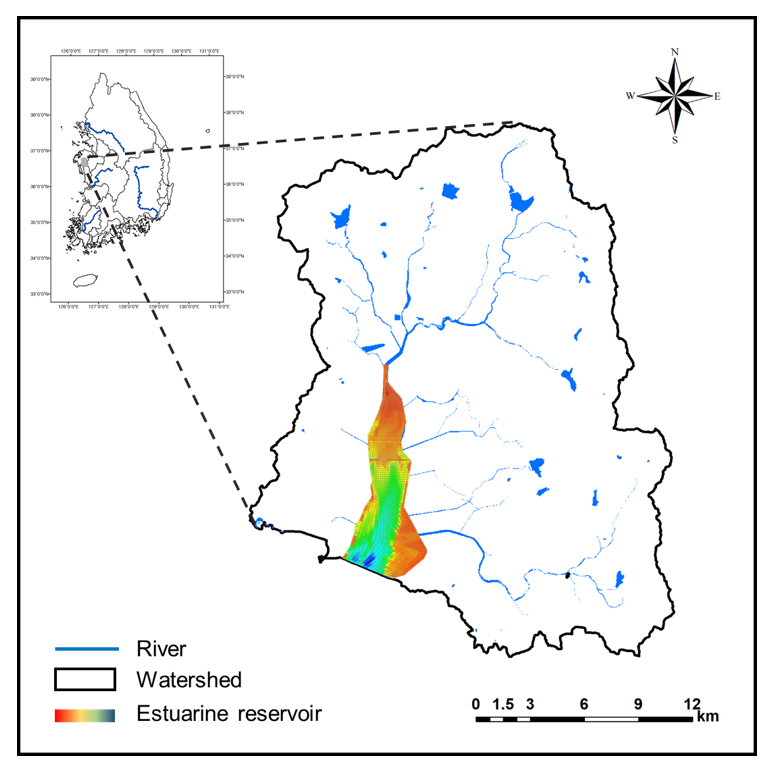
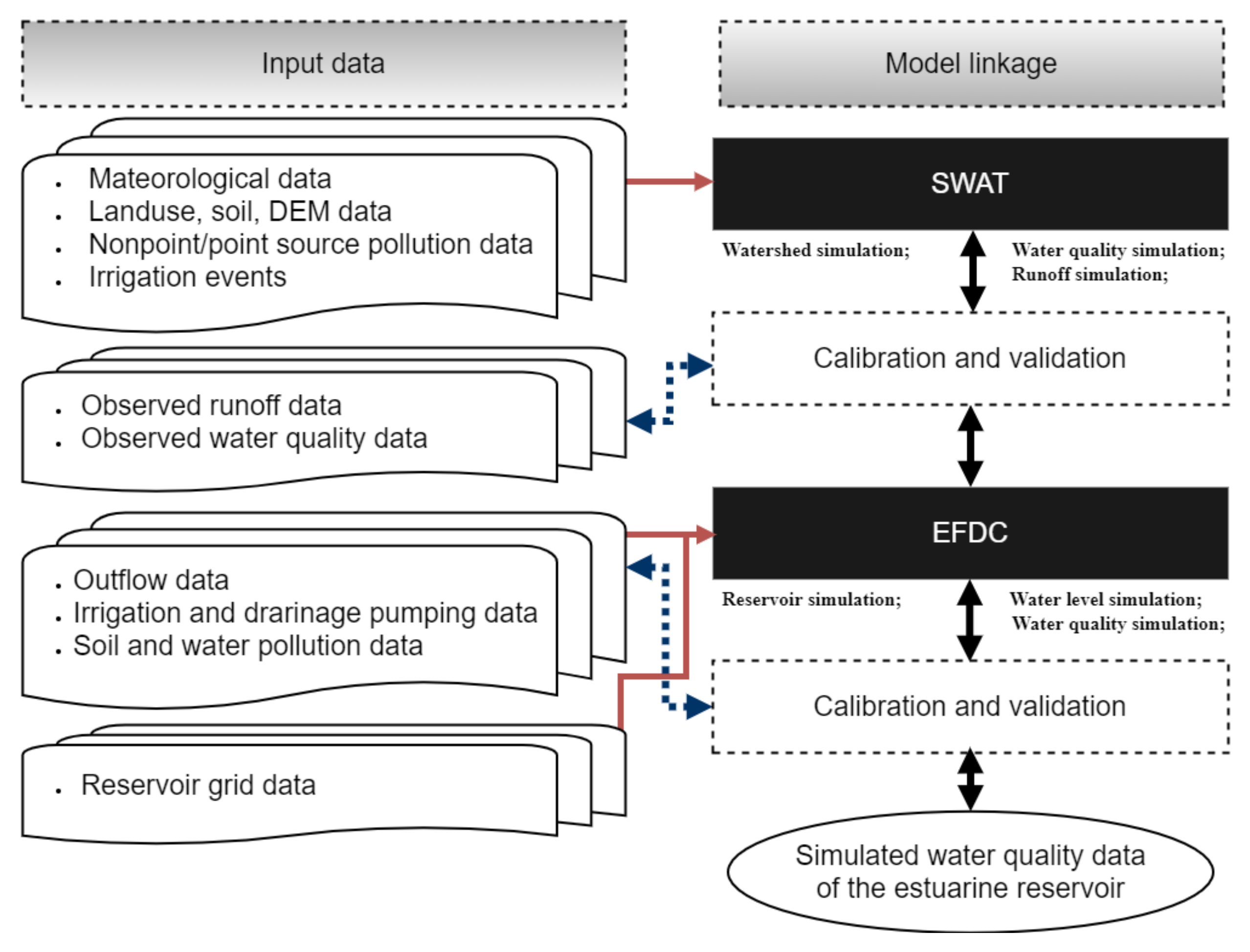
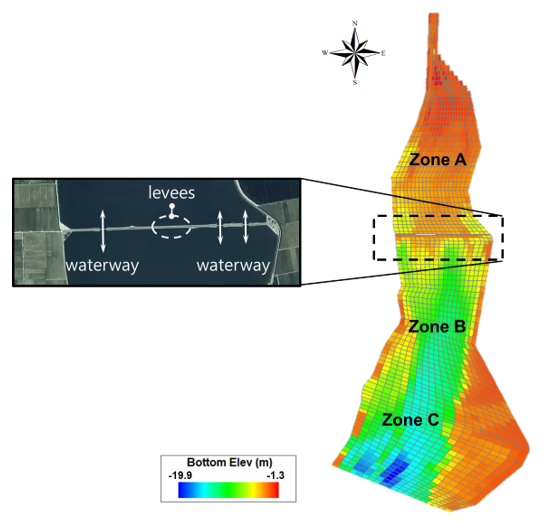
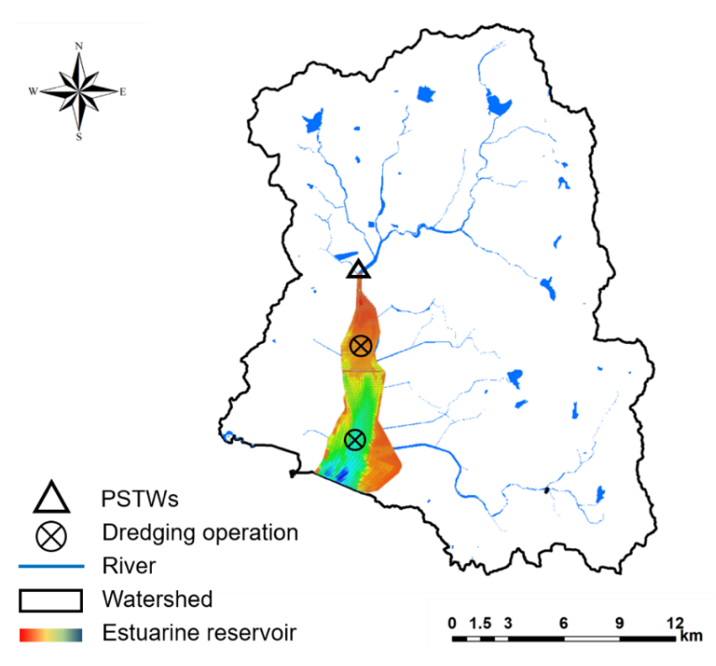

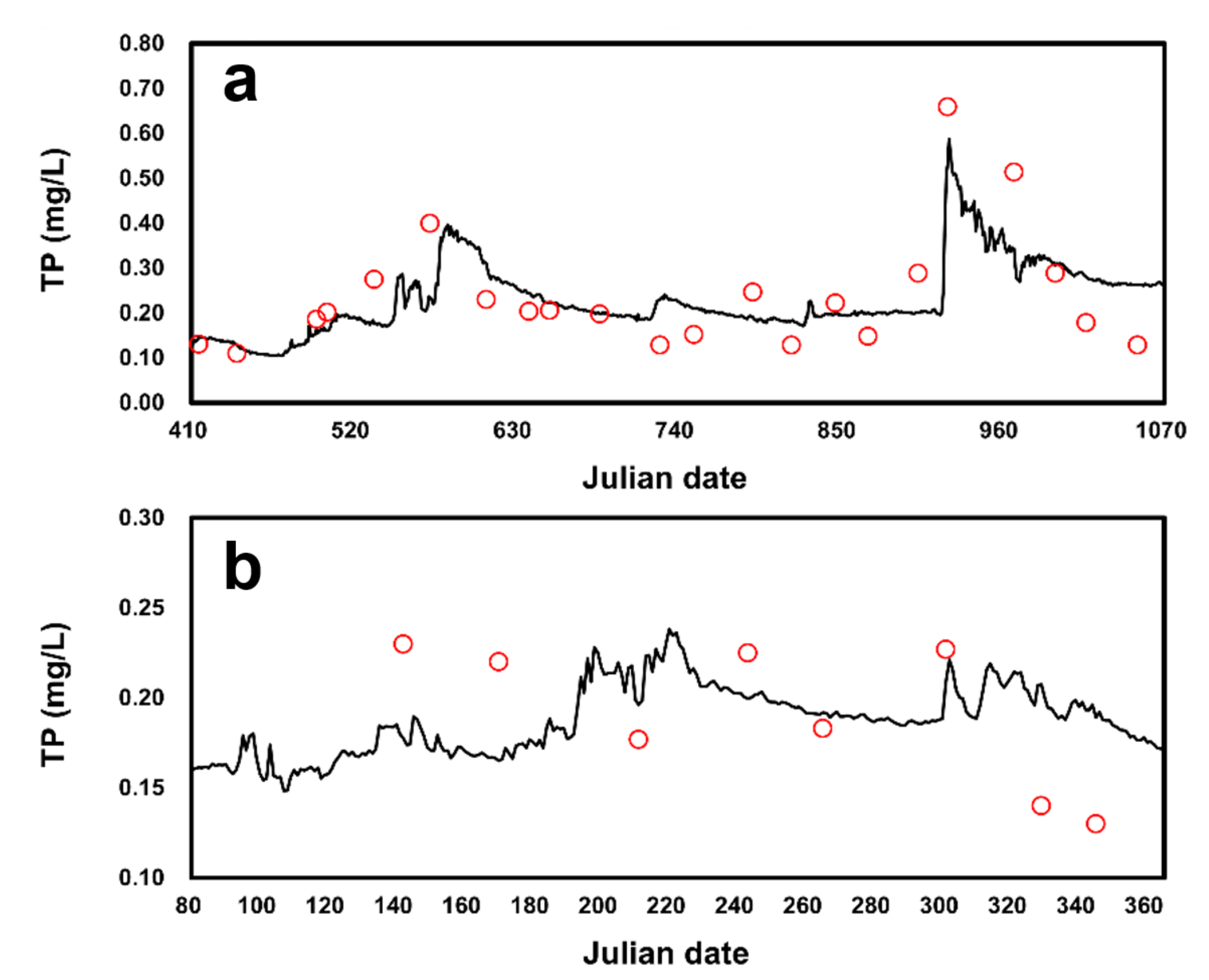

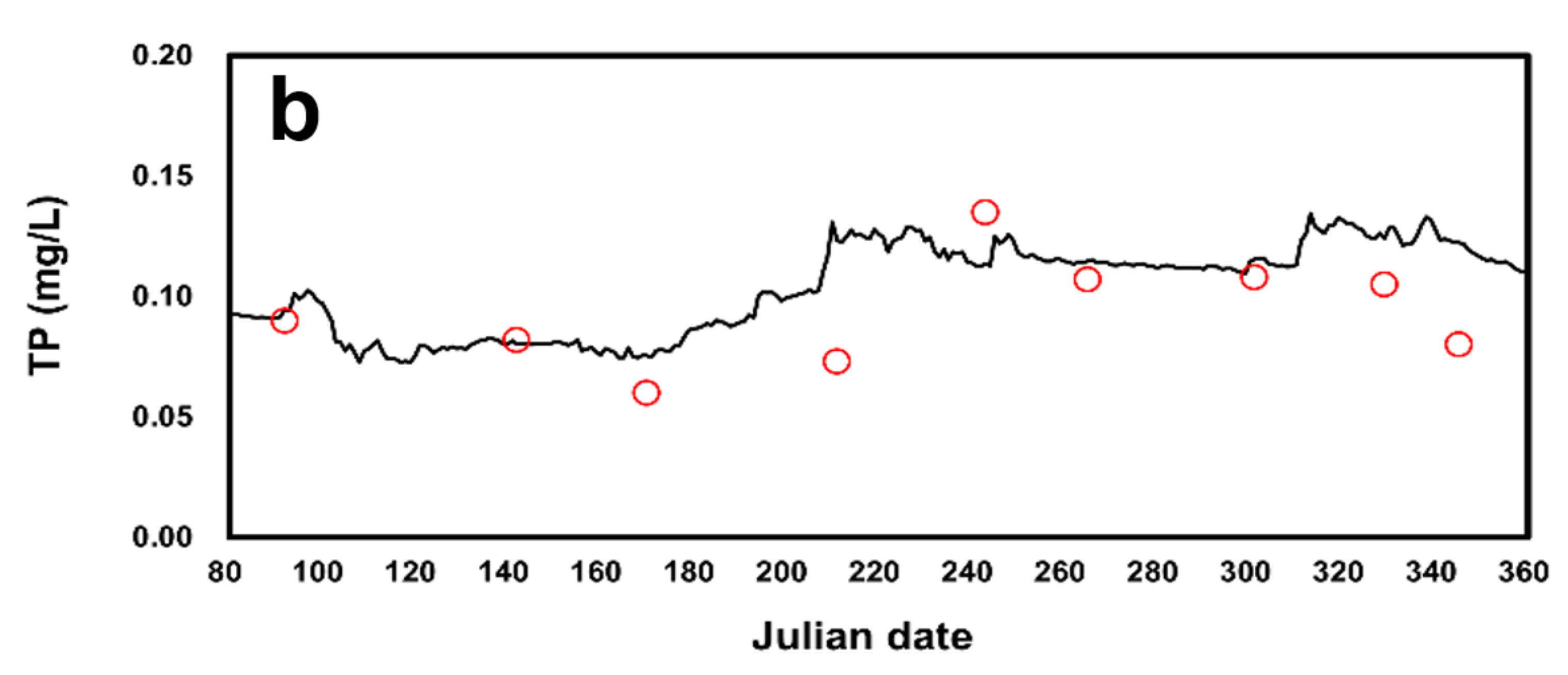
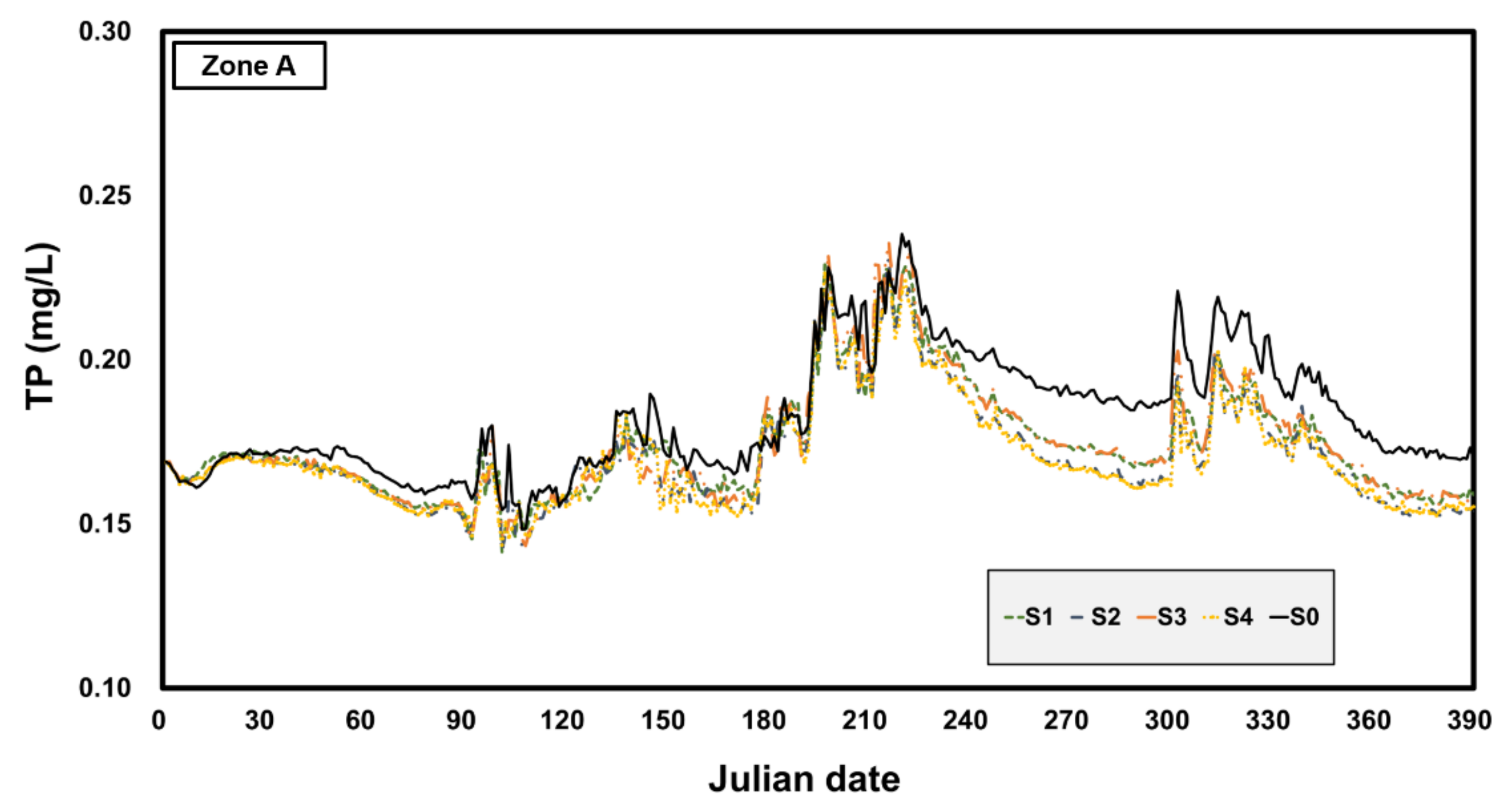
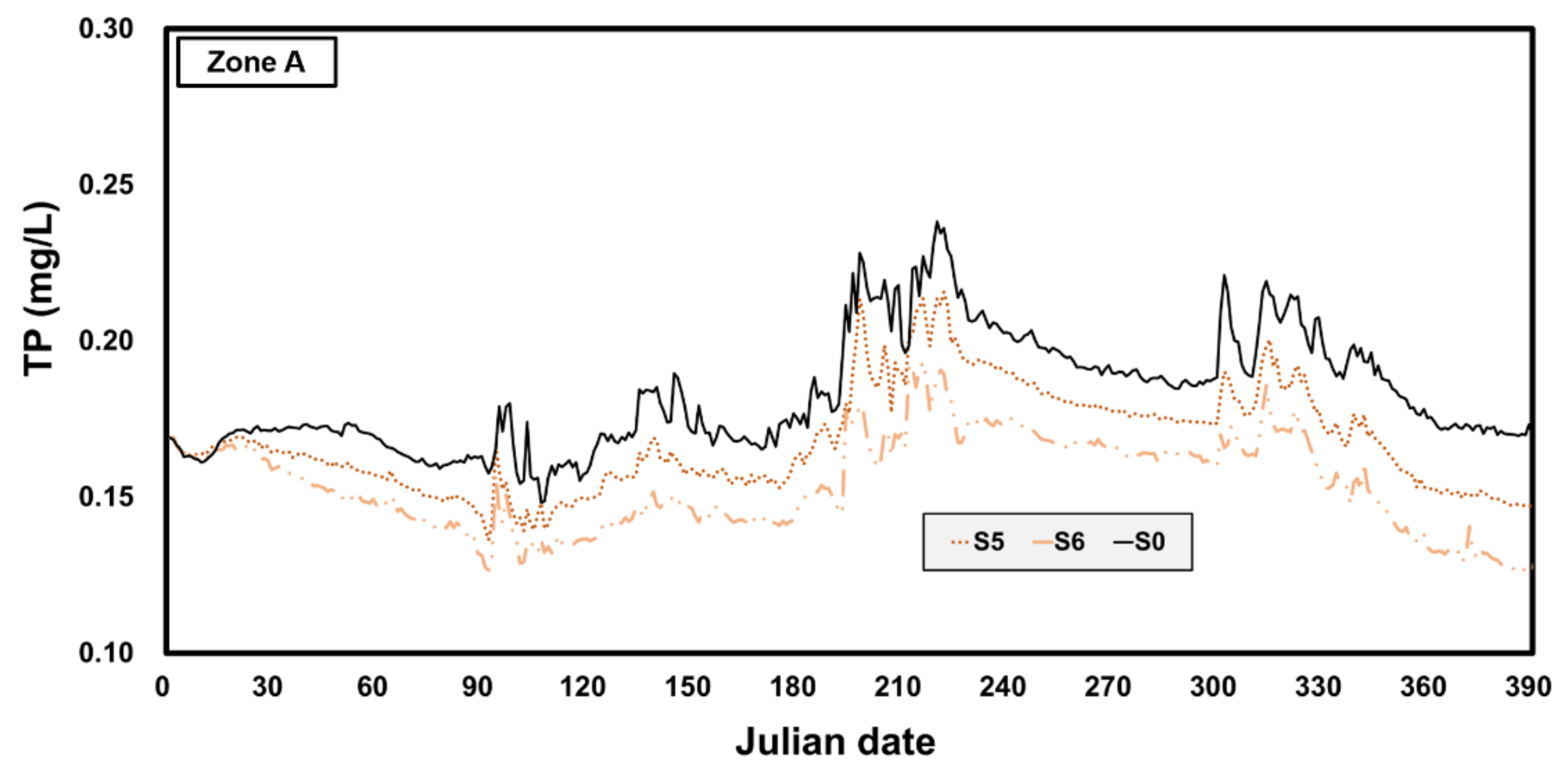
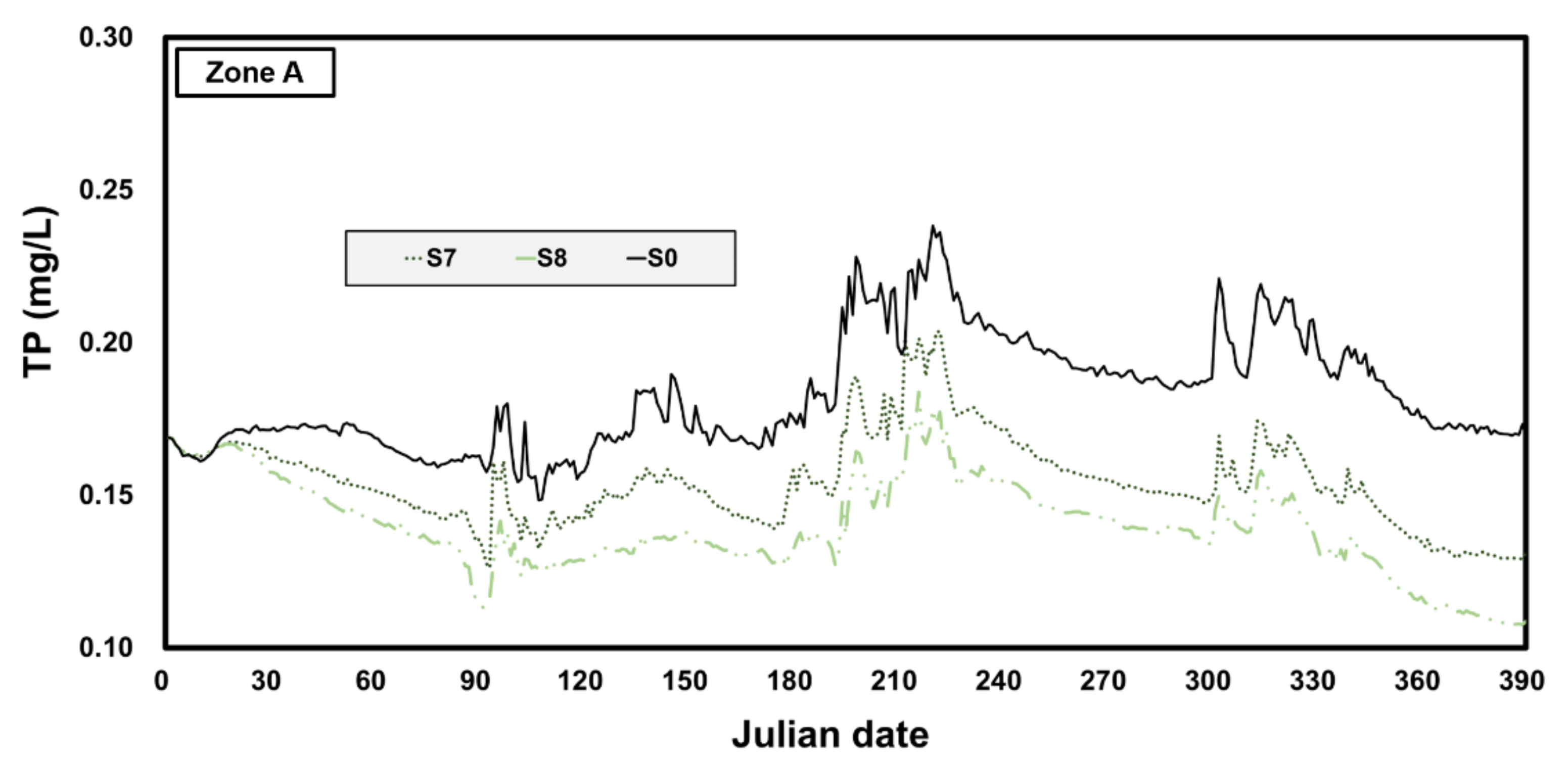



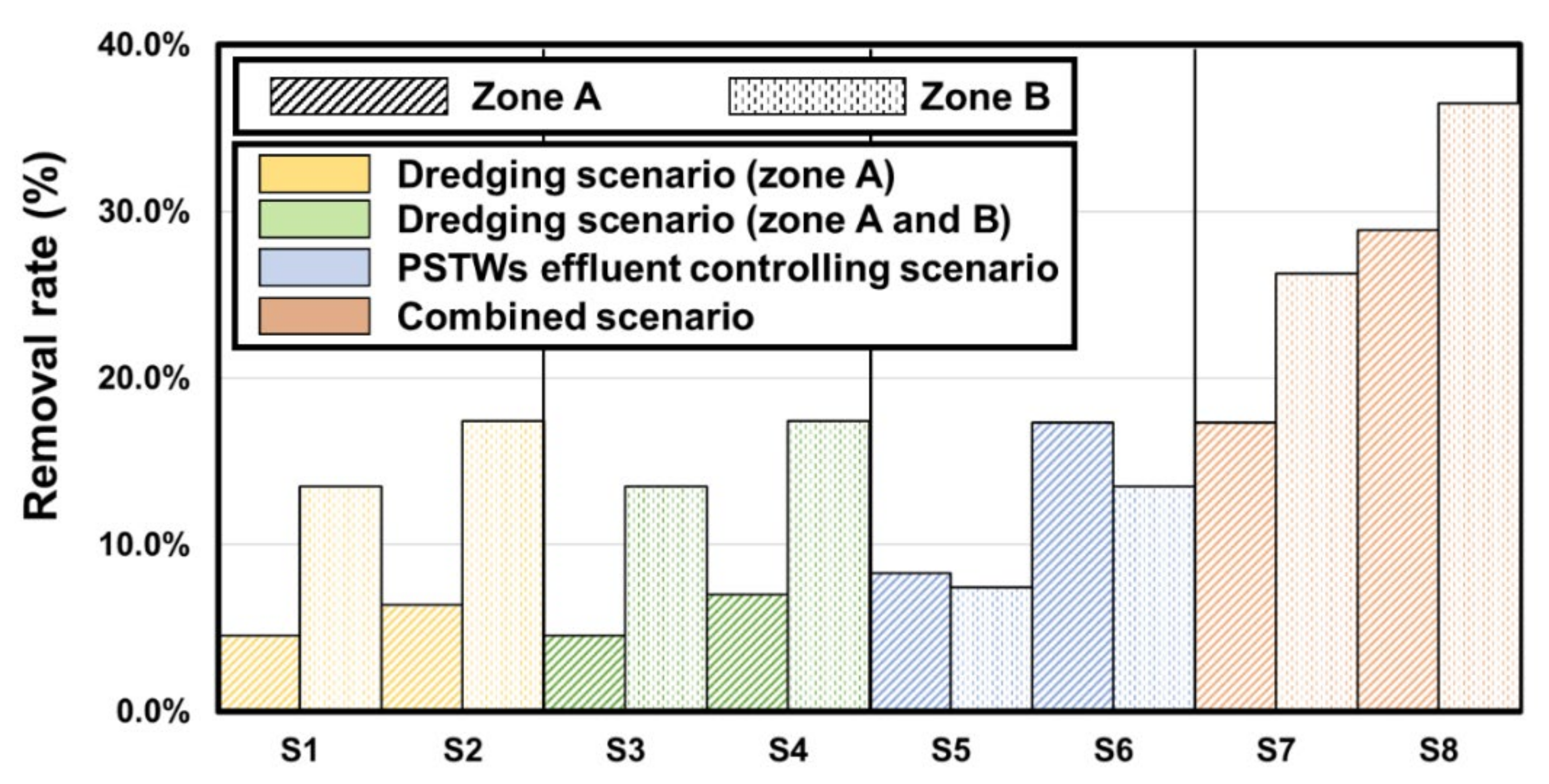
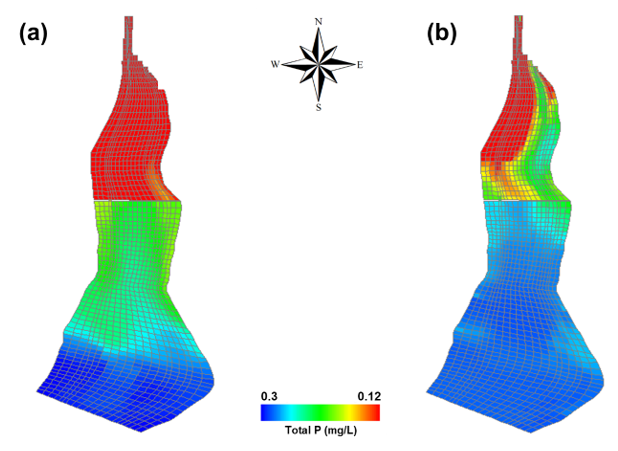
| Abbreviations | Expanded Form or Meaning |
|---|---|
| SWAT | Soil and water assessment tool |
| EFDC | Environmental fluid dynamics code |
| HSPF | Hydrological simulation program-Fortran |
| PSTWs | Public sewage treatment works |
| BMP | Best management practices |
| EnKF | Ensemble Kalman filter |
| O/S | (observed average)/(simulated average) |
| Ave. | Average |
| cal. | Calibration |
| val. | Validation |
| Sampling Date | Content | Ignition Loss (%) | Organic Matter (%) | T-N (%) | T-P (mg/kg) |
|---|---|---|---|---|---|
| 24 May 2018 | Zone A | 3.7 | 2.10 | 0.154 | 607.46 |
| Zone B | 0.8 | 0.50 | 0.058 | 448.03 | |
| Zone C | 0.9 | 0.25 | 0.042 | 385.88 | |
| 13 July 2018 | Zone A | 2.1 | 1.20 | 0.081 | 450.03 |
| Zone B | 0.6 | 0.99 | 0.073 | 417.13 | |
| Zone C | 0.4 | 1.36 | 0.102 | 409.50 |
| Scenario | Content |
|---|---|
| No scenario | Scenario 0 (Now) |
| Group A: Dredging operation in Zone A | Scenario 1 (P and N leaching rate 60% reduction) |
| Scenario 2 (P and N leaching rate 80% reduction) | |
| Group B: Dredging operation in Zones A and B | Scenario 3 (with Scenario 3) (P and N leaching rate 40% reduction in Zone B) |
| Scenario 4 (with Scenario 4) (P and N leaching rate 40% reduction in Zone B) | |
| Group C: Effluent control from PSTWs | Scenario 5 (50% T-P effluent reduction) |
| Scenario 6 (90% T-P effluent reduction) | |
| Group D: Combined scenario | Scenario 7 (Scenario 4 and Scenario 5) |
| Scenario 8 (Scenario 4 and Scenario 6) |
| Location | Content | TEMP | DO | T-P (cal.) (2016–2017) | T-P (val.) (2015) |
|---|---|---|---|---|---|
| Zone A-observation point | Observed Ave. | 16.64 | 10.34 | 0.242 | 0.201 |
| Simulated Ave. | 17.17 | 10.41 | 0.232 | 0.186 | |
| O/S | 0.969 | 0.993 | 0.957 | 0.927 | |
| Zone B-observation point | Observed Ave. | 16.60 | 11.99 | 0.143 | 0.105 |
| Simulated Ave. | 17.32 | 10.62 | 0.148 | 0.101 | |
| O/S | 0.959 | 1.128 | 0.964 | 0.961 |
Publisher’s Note: MDPI stays neutral with regard to jurisdictional claims in published maps and institutional affiliations. |
© 2021 by the authors. Licensee MDPI, Basel, Switzerland. This article is an open access article distributed under the terms and conditions of the Creative Commons Attribution (CC BY) license (https://creativecommons.org/licenses/by/4.0/).
Share and Cite
Hwang, S.; Jun, S.-M.; Song, J.-H.; Kim, K.; Kim, H.; Kang, M.-S. Application of the SWAT-EFDC Linkage Model for Assessing Water Quality Management in an Estuarine Reservoir Separated by Levees. Appl. Sci. 2021, 11, 3911. https://doi.org/10.3390/app11093911
Hwang S, Jun S-M, Song J-H, Kim K, Kim H, Kang M-S. Application of the SWAT-EFDC Linkage Model for Assessing Water Quality Management in an Estuarine Reservoir Separated by Levees. Applied Sciences. 2021; 11(9):3911. https://doi.org/10.3390/app11093911
Chicago/Turabian StyleHwang, Soonho, Sang-Min Jun, Jung-Hun Song, Kyeung Kim, Hakkwan Kim, and Moon-Seong Kang. 2021. "Application of the SWAT-EFDC Linkage Model for Assessing Water Quality Management in an Estuarine Reservoir Separated by Levees" Applied Sciences 11, no. 9: 3911. https://doi.org/10.3390/app11093911







